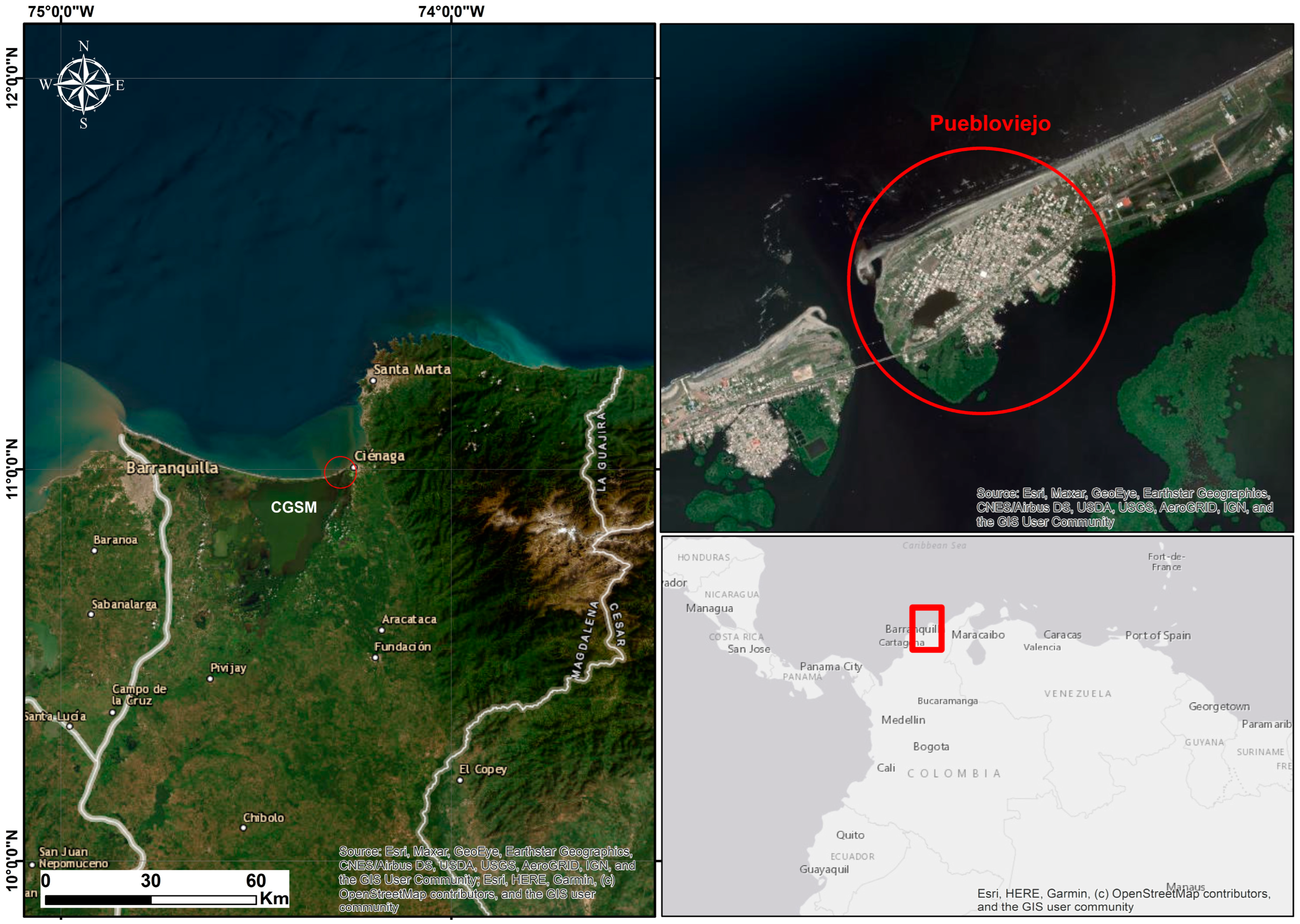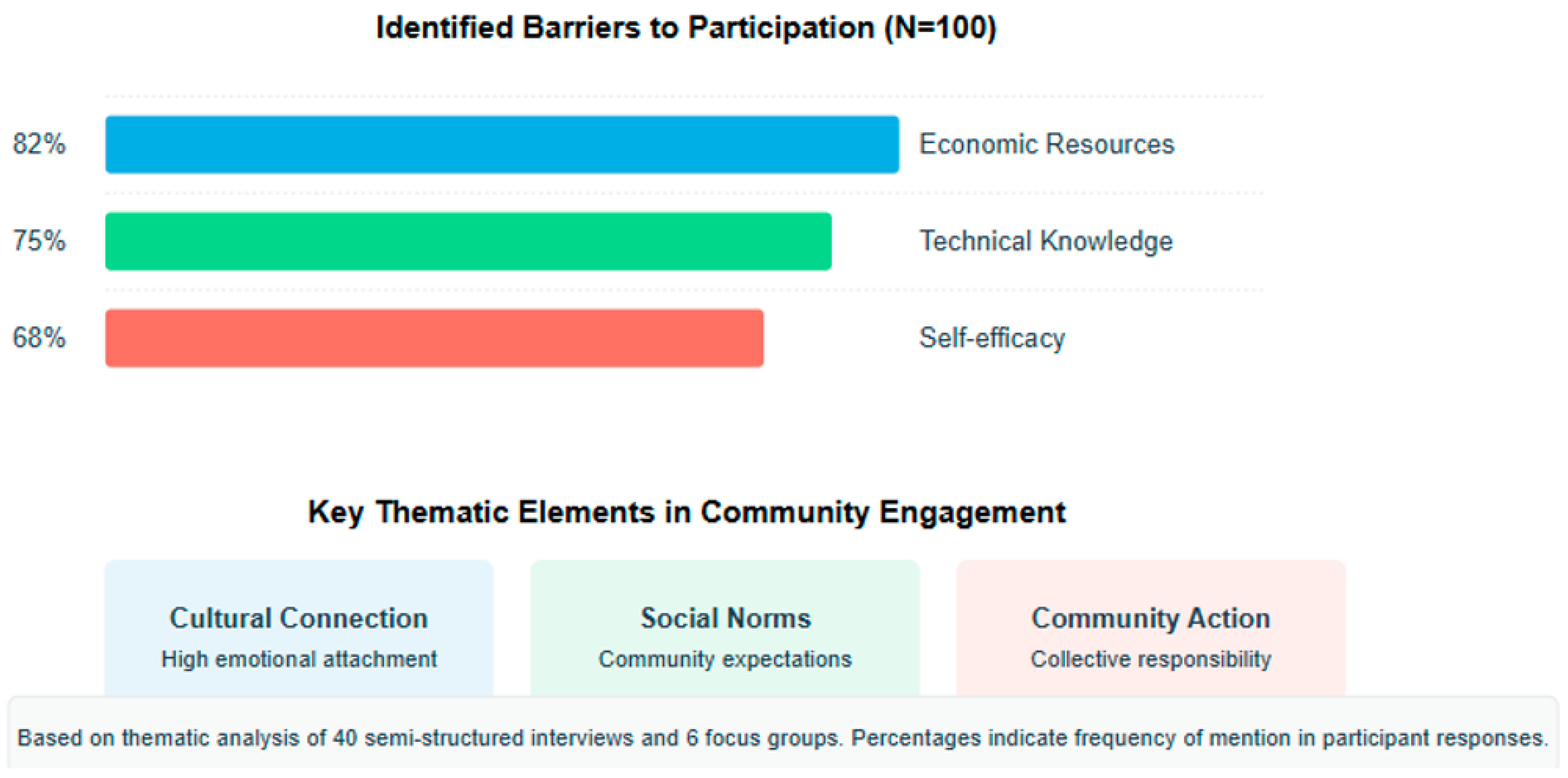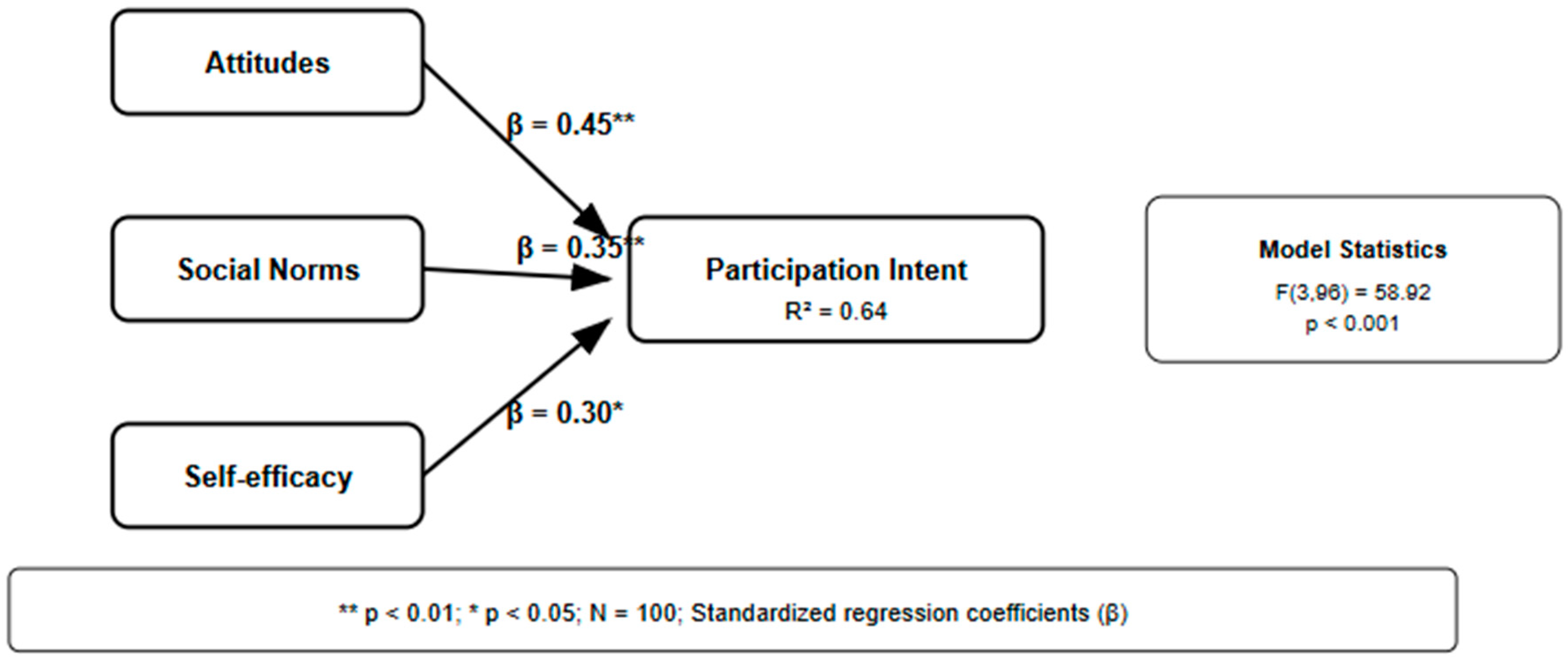Environmental Psychology and Mangrove Reforestation in the Ciénaga Grande de Santa Marta, Colombia: An Approach to Ecosystem Restoration
Abstract
1. Introduction
2. Materials and Methods
2.1. Study Area and Population Characterization
2.2. Study Design and Population
- Residence in the region for more than five years.
- Direct economic dependence on mangrove ecosystems (fishing or tourism)
- Previous participation in reforestation or conservation activities.
- Representation of different age groups and community roles.
2.3. Data Collection
2.3.1. Qualitative Phase
- Perceptions about the mangrove ecosystem
- Experiences in environmental conservation
- Barriers to community participation
- Motivating factors for conservation
- Artisanal fishermen
- Community leaders
- Female heads of household
- Young people between 18–29 years old
2.3.2. Quantitative Phase
- Attitudes toward reforestation
- Perceived social norms
- Self-efficacy
- Emotional connection with nature
2.4. Procedure and Data Analysis
2.5. Statistical Analysis
Multiple Regression Analysis and Multicollinearity Testing
- A VIF threshold of < 5 was established as the inclusion criteria
- All independent variables in the final model showed VIF values < 3:
- Environmental attitudes (VIF = 2.3)
- Perceived social norms (VIF = 2.1)
- Self-efficacy (VIF = 1.8)
- Nature connectedness (VIF = 2.4)
- Sociodemographic control variables (all VIF < 1.5)
- Tolerance values (1/VIF) all exceeded 0.40
- Condition index values were < 30
- Variance proportions were examined for each eigenvalue
- Combined into composite indices when representing related constructs
- Analyzed in separate models when theoretically relevant
- Excluded from the final model
2.6. Ethical Considerations
3. Results
3.1. Qualitative Analysis of Community Perceptions and Barriers
3.1.1. Sociocultural Link with the Ecosystem
3.1.2. Dynamics of Social Norms
3.1.3. Barriers to Effective Participation
- Economic constraints (mentioned by 82% of participants)
- Lack of technical knowledge of reforestation practices (75%)
- Low perception of individual self-efficacy (68%)
3.2. Quantitative Analysis of Psychosocial Factors
3.2.1. Attitudes and Willingness Towards Reforestation
3.2.2. Influence of Social Norms
3.2.3. Self-Efficacy and Perception of Control
3.2.4. Emotional Connection with the Ecosystem
- Positive Attitudes: Combined measure of environmental conservation beliefs and behavioral intentions
- Social Norms: Perceived community expectations and peer influence on conservation behavior
- Emotional Connection: Measured through nature connectedness scale and local ecosystem value perception
- Self-efficacy: Assessed through perceived ability to contribute meaningfully to restoration efforts
3.2.5. Multivariate Analysis of Predictors
- Attitudes (β = 0.45, p < 0.01)
- Perceived social norms (β = 0.35, p < 0.01)
- Self-efficacy (β = 0.30, p < 0.05)
3.3. Integration of Qualitative and Quantitative Findings
3.3.1. Social Norms and Community Participation
3.3.2. Self-Efficacy and Participation Barriers
3.3.3. Emotional Connection and Environmental Commitment
3.3.4. Socioeconomic Factors and Participation
- Leverage the positive influence of social norms
- Strengthen the perception of community self-efficacy
- Capitalize on the strong emotional connection with the ecosystem
- Consider socioeconomic constraints in program design
4. Discussion
5. Conclusions
6. Recommendations
Supplementary Materials
Author Contributions
Funding
Institutional Review Board Statement
Informed Consent Statement
Data Availability Statement
Acknowledgments
Conflicts of Interest
References
- Kantamaneni, K.; Gallagher, A.; Du, X. Assessing and Mapping Regional Coastal Vulnerability for Port Environments and Coastal Cities. J. Coast. Conserv. 2019, 23, 59–70. [Google Scholar] [CrossRef]
- Bimrah, K.; Dasgupta, R.; Hashimoto, S.; Saizen, I.; Dhyani, S. Ecosystem Services of Mangroves: A Systematic Review and Synthesis of Contemporary Scientific Literature. Sustainability 2022, 14, 12051. [Google Scholar] [CrossRef]
- Sun, Y.; Ye, M.; Jian, Z.; Ai, B.; Zhao, J.; Chen, Q. Species Classification and Carbon Stock Assessment of Mangroves in Qi’ao Island with Worldview-3 Imagery. Forests 2023, 14, 2356. [Google Scholar] [CrossRef]
- Alongi, D.M. Global Significance of Mangrove Blue Carbon in Climate Change Mitigation. Sci 2020, 2, 67. [Google Scholar] [CrossRef]
- Friess, D.A.; Yando, E.S.; Abuchahla, G.M.O.; Adams, J.B.; Cannicci, S.; Canty, S.W.J.; Cavanaugh, K.C.; Connolly, R.M.; Cormier, N.; Dahdouh-Guebas, F.; et al. Mangroves Give Cause for Conservation Optimism, for Now. Curr. Biol. 2020, 30, R153–R154. [Google Scholar] [CrossRef]
- Rudianto, R.; Bengen, D.G.; Kurniawan, F. Causes and Effects of Mangrove Ecosystem Damage on Carbon Stocks and Absorption in East Java, Indonesia. Sustainability 2020, 12, 10319. [Google Scholar] [CrossRef]
- Vilardy, S.P.; González, J.A.; Martín-López, B.; Montes, C. Relationships between Hydrological Regime and Ecosystem Services Supply in a Caribbean Coastal Wetland: A Social-Ecological Approach. Hydrol. Sci. J. 2011, 56, 1423–1435. [Google Scholar] [CrossRef]
- Botero, L.; Salzwedel, H. Rehabilitation of the Cienaga Grande de Santa Marta, a Mangrove-Estuarine System in the Caribbean Coast of Colombia. Ocean Coast. Manag. 1999, 42, 243–256. [Google Scholar] [CrossRef]
- Garcés-Ordóñez, O.; Bayona-Arenas, M.R. Impactos de la contaminación por basura marina en el ecosistema de manglar de la Ciénaga Grande de Santa Marta, Caribe colombiano. Rev. Cienc. Mar. Costeras 2019, 11, 145–165. [Google Scholar] [CrossRef]
- Dale, V.H.; Beyeler, S.C.; Jackson, B. Understory Vegetation Indicators of Anthropogenic Disturbance in Longleaf Pine Forests at Fort Benning, Georgia, USA. Ecol. Indic. 2002, 1, 155–170. [Google Scholar] [CrossRef]
- Veríssimo, D.; Vaughan, G.; Ridout, M.; Waterman, C.; MacMillan, D.; Smith, R.J. Increased Conservation Marketing Effort Has Major Fundraising Benefits for Even the Least Popular Species. Biol. Conserv. 2017, 211, 95–101. [Google Scholar] [CrossRef]
- Sterling, E.J.; Betley, E.; Sigouin, A.; Gomez, A.; Toomey, A.; Cullman, G.; Malone, C.; Pekor, A.; Arengo, F.; Blair, M.; et al. Assessing the Evidence for Stakeholder Engagement in Biodiversity Conservation. Biol. Conserv. 2017, 209, 159–171. [Google Scholar] [CrossRef]
- Richardson, M.; Passmore, H.-A.; Barbett, L.; Lumber, R.; Thomas, R.; Hunt, A. The Green Care Code: How Nature Connectedness and Simple Activities Help Explain pro-Nature Conservation Behaviours. People Nat. 2020, 2, 821–839. [Google Scholar] [CrossRef]
- Simard, M.; Fatoyinbo, L.; Smetanka, C.; Rivera-Monroy, V.H.; Castañeda-Moya, E.; Thomas, N.; Van der Stocken, T. Mangrove Canopy Height Globally Related to Precipitation, Temperature and Cyclone Frequency. Nat. Geosci. 2019, 12, 40–45. [Google Scholar] [CrossRef]
- Blanco-Libreros, J.F.; Álvarez-Leó, R. Mangroves of Colombia Revisited in an Era of Open Data, Global Changes, and Socio-Political Transition: Homage to Heliodoro Sánchez-Páez. Rev. Acad. Colomb. Cienc. Exactas Físicas Nat. 2019, 43, 84–97. [Google Scholar] [CrossRef]
- Mackay, C.M.L.; Schmitt, M.T. Do People Who Feel Connected to Nature Do More to Protect It? A Meta-Analysis. J. Environ. Psychol. 2019, 65, 101323. [Google Scholar] [CrossRef]
- Ajzen, I.; Fishbein, M. The Influence of Attitudes on Behavior. In The Handbook of Attitudes; Lawrence Erlbaum Associates Publishers: Mahwah, NJ, USA, 2005; pp. 173–221. ISBN 978-0-8058-4492-4. [Google Scholar]
- Neale, C.; Lopez, S.; Roe, J. Psychological Restoration and the Effect of People in Nature and Urban Scenes: A Laboratory Experiment. Sustainability 2021, 13, 6464. [Google Scholar] [CrossRef]
- Ke, G.-N.; Utama, I.K.A.P.; Wagner, T.; Sweetman, A.K.; Arshad, A.; Nath, T.K.; Neoh, J.Y.; Muchamad, L.S.; Suroso, D.S.A. Influence of Mangrove Forests on Subjective and Psychological Wellbeing of Coastal Communities: Case Studies in Malaysia and Indonesia. Front. Public Health 2022, 10, 898276. [Google Scholar] [CrossRef]
- Abdullah, K.; Said, A.M.; Omar, D. Community-Based Conservation in Managing Mangrove Rehabilitation in Perak and Selangor. Procedia—Soc. Behav. Sci. 2014, 153, 121–131. [Google Scholar] [CrossRef][Green Version]
- Kibler, K.; Cook, G.; Chambers, L.; Donnelly, M.; Hawthorne, T.; Rivera, F.; Walters, L. Integrating Sense of Place into Ecosystem Restoration: A Novel Approach to Achieve Synergistic Social-Ecological Impact. Ecol. Soc. 2018, 23, 25. [Google Scholar] [CrossRef]
- Quiroga, S.V. Estructura y dinámica de la ecorregión Ciénaga Grande de Santa Marta: Una aproximación desde el marco Conceptual de los Sistemas Socio-ecológicos Complejos y la teoría de la Resilencia. Doctoral Thesis, Universidad Autónoma de Madrid, Madrid, Spain, 2009. [Google Scholar]
- Bratman, G.N.; Hamilton, J.P.; Hahn, K.S.; Daily, G.C.; Gross, J.J. Nature Experience Reduces Rumination and Subgenual Prefrontal Cortex Activation. Proc. Natl. Acad. Sci. USA 2015, 112, 8567–8572. [Google Scholar] [CrossRef] [PubMed]
- Thuy, P.T.; Hue, N.T.; Dat, L.Q. Households’ Willingness-to-Pay for Mangrove Environmental Services: Evidence from Phu Long, Northeast Vietnam. Trees For. People 2024, 15, 100474. [Google Scholar] [CrossRef]
- Del Cid-Alvarado, R.J.; Lopez, O.R.; Rodríguez-González, P.M.; Feás-Vázquez, J. Social Perception and Engagement in Mangrove Restoration: A Case Study in Central America. Land 2024, 13, 1783. [Google Scholar] [CrossRef]
- Lee, M.-T.; Liu, J.-M.; Borazon, E.Q. Evaluating the Effect of Perceived Value of Ecosystem Services on Tourists’ Behavioral Intentions for Aogu Coastal Wetland. Sustainability 2020, 12, 6214. [Google Scholar] [CrossRef]
- Raymond, C.M.; Brown, G.; Robinson, G.M. The Influence of Place Attachment, and Moral and Normative Concerns on the Conservation of Native Vegetation: A Test of Two Behavioural Models. J. Environ. Psychol. 2011, 31, 323–335. [Google Scholar] [CrossRef]
- Whitburn, J.; Linklater, W.; Abrahamse, W. Meta-Analysis of Human Connection to Nature and Proenvironmental Behavior. Conserv. Biol. 2020, 34, 180–193. [Google Scholar] [CrossRef] [PubMed]
- Rosa, C.D.; Profice, C.C.; Collado, S. Nature Experiences and Adults’ Self-Reported Pro-Environmental Behaviors: The Role of Connectedness to Nature and Childhood Nature Experiences. Front. Psychol. 2018, 9, 1055. [Google Scholar] [CrossRef] [PubMed]
- Chen, Z.; He, Y.; Yu, Y. Enhanced Functional Connectivity Properties of Human Brains during In-Situ Nature Experience. PeerJ 2016, 4, e2210. [Google Scholar] [CrossRef]
- Walters, B.B.; Rönnbäck, P.; Kovacs, J.M.; Crona, B.; Hussain, S.A.; Badola, R.; Primavera, J.H.; Barbier, E.; Dahdouh-Guebas, F. Ethnobiology, Socio-Economics and Management of Mangrove Forests: A Review. Aquat. Bot. 2008, 89, 220–236. [Google Scholar] [CrossRef]
- Wyborn, C.; Datta, A.; Montana, J.; Ryan, M.; Leith, P.; Chaffin, B.; Miller, C.; van Kerkhoff, L. Co-Producing Sustainability: Reordering the Governance of Science, Policy, and Practice. Annu. Rev. Environ. Resour. 2019, 44, 319–346. [Google Scholar] [CrossRef]
- Castellanos-Galindo, G.A.; Kluger, L.C.; Camargo, M.A.; Cantera, J.; Mancera Pineda, J.E.; Blanco-Libreros, J.F.; Wolff, M. Mangrove Research in Colombia: Temporal Trends, Geographical Coverage and Research Gaps. Estuar. Coast. Shelf Sci. 2021, 248, 106799. [Google Scholar] [CrossRef]
- Ramirez, L.F. Marine Protected Areas in Colombia: Advances in Conservation and Barriers for Effective Governance. Ocean Coast. Manag. 2016, 125, 49–62. [Google Scholar] [CrossRef]
- DNP Índices e Indicadores de Desarrollo Territorial: Puebloviejo, Magdalena. Available online: https://colaboracion.dnp.gov.co/CDT/Desarrollo%20Territorial/Portal%20Territorial/Bioceanica/Muns/Puebloviejo-MAGDALENA.pdf (accessed on 28 November 2024).
- Garay Tinoco, J.; Restrepo Martinez, J.; Casas Monroy, O.; Solano P., O.D.; Newmark Umbreit, R.F. Los Manglares de la Ecorregión Ciénaga Grande de Santa Marta: Pasado, Presente y Futuro; Publicaciones Especiales; INVEMAR: Santa Marta, Colombia, 2004; ISBN 978-958-97349-2-6. [Google Scholar]
- Johnson, R.B.; Onwuegbuzie, A.J.; Turner, L.A. Toward a Definition of Mixed Methods Research. J. Mix. Methods Res. 2007, 1, 112–133. [Google Scholar] [CrossRef]
- Clarke, N.J.; Willis, M.E.H.; Barnes, J.S.; Caddick, N.; Cromby, J.; McDermott, H.; Wiltshire, G. Analytical Pluralism in Qualitative Research: A Meta-Study. Qual. Res. Psychol. 2015, 12, 182–201. [Google Scholar] [CrossRef]
- Braun, V.; Clarke, V. Using Thematic Analysis in Psychology. Qual. Res. Psychol. 2006, 3, 77–101. [Google Scholar] [CrossRef]
- Ajzen, I. The Theory of Planned Behavior. Organ. Behav. Hum. Decis. Process. 1991, 50, 179–211. [Google Scholar] [CrossRef]
- Kvale, S. Las Entrevistas en Investigación Cualitativa; Ediciones Morata: Madrid, Spain, 2011; ISBN 978-84-7112-630-6. [Google Scholar]
- Winkel, G.; Saegert, S.; Evans, G.W. An Ecological Perspective on Theory, Methods, and Analysis in Environmental Psychology: Advances and Challenges. J. Environ. Psychol. 2009, 29, 318–328. [Google Scholar] [CrossRef]
- Mayer, F.S.; Frantz, C.M. The Connectedness to Nature Scale: A Measure of Individuals’ Feeling in Community with Nature. J. Environ. Psychol. 2004, 24, 503–515. [Google Scholar] [CrossRef]
- Liu, T.; Geng, L.; Ye, L.; Zhou, K. “Mother Nature” Enhances Connectedness to Nature and pro-Environmental Behavior. J. Environ. Psychol. 2019, 61, 37–45. [Google Scholar] [CrossRef]
- Fetters, M.D.; Molina-Azorin, J.F. The Journal of Mixed Methods Research Starts a New Decade: Principles for Bringing in the New and Divesting of the Old Language of the Field. J. Mix. Methods Res. 2017, 11, 3–10. [Google Scholar] [CrossRef]
- Schoonenboom, J.; Johnson, R.B. How to Construct a Mixed Methods Research Design. KZfSS Köln. Z. Für Soziol. Sozialpsychologie 2017, 69, 107–131. [Google Scholar] [CrossRef] [PubMed]
- Thomas, E.F.; McGarty, C.; Mavor, K.I. Transforming “Apathy Into Movement”: The Role of Prosocial Emotions in Motivating Action for Social Change. Personal. Soc. Psychol. Rev. 2009, 13, 310–333. [Google Scholar] [CrossRef] [PubMed]
- Fielding, K.S.; McDonald, R.; Louis, W.R. Theory of Planned Behaviour, Identity and Intentions to Engage in Environmental Activism. J. Environ. Psychol. 2008, 28, 318–326. [Google Scholar] [CrossRef]
- Fritsche, I.; Barth, M.; Jugert, P.; Masson, T.; Reese, G. A Social Identity Model of Pro-Environmental Action (SIMPEA). Psychol. Rev. 2018, 125, 245–269. [Google Scholar] [CrossRef] [PubMed]
- Swami, V.; Barron, D.; Weis, L.; Furnham, A. Bodies in Nature: Associations between Exposure to Nature, Connectedness to Nature, and Body Image in U.S. Adults. Body Image 2016, 18, 153–161. [Google Scholar] [CrossRef] [PubMed]
- Bennett, N.J.; Roth, R.; Klain, S.C.; Chan, K.; Christie, P.; Clark, D.A.; Cullman, G.; Curran, D.; Durbin, T.J.; Epstein, G.; et al. Conservation Social Science: Understanding and Integrating Human Dimensions to Improve Conservation. Biol. Conserv. 2017, 205, 93–108. [Google Scholar] [CrossRef]
- Steg, L.; Vlek, C. Encouraging Pro-Environmental Behaviour: An Integrative Review and Research Agenda. J. Environ. Psychol. 2009, 29, 309–317. [Google Scholar] [CrossRef]
- Vlek, C.; Steg, L. ⊡ Human Behavior and Environmental Sustainability: Problems, Driving Forces, and Research Topics. J. Soc. Issues 2007, 63, 1–19. [Google Scholar] [CrossRef]
- Richardson, M.; Hunt, A.; Hinds, J.; Bragg, R.; Fido, D.; Petronzi, D.; Barbett, L.; Clitherow, T.; White, M. A Measure of Nature Connectedness for Children and Adults: Validation, Performance, and Insights. Sustainability 2019, 11, 3250. [Google Scholar] [CrossRef]
- Bamberg, S.; Möser, G. Twenty Years after Hines, Hungerford, and Tomera: A New Meta-Analysis of Psycho-Social Determinants of pro-Environmental Behaviour. J. Environ. Psychol. 2007, 27, 14–25. [Google Scholar] [CrossRef]
- Richardson, M.; Passmore, H.-A.; Lumber, R.; Thomas, R.; Hunt, A. Moments, Not Minutes: The Nature-Wellbeing Relationship. Int. J. Wellbeing 2021, 11, 8–33. [Google Scholar] [CrossRef]
- López-Angarita, J.; Tilley, A.; Hawkins, J.P.; Pedraza, C.; Roberts, C.M. Land Use Patterns and Influences of Protected Areas on Mangroves of the Eastern Tropical Pacific. Biol. Conserv. 2018, 227, 82–91. [Google Scholar] [CrossRef]
- Bennett, N.J.; Whitty, T.S.; Finkbeiner, E.; Pittman, J.; Bassett, H.; Gelcich, S.; Allison, E.H. Environmental Stewardship: A Conceptual Review and Analytical Framework. Environ. Manag. 2018, 61, 597–614. [Google Scholar] [CrossRef] [PubMed]
- Marshall, N.A.; Thiault, L.; Beeden, A.; Beeden, R.; Benham, C.; Curnock, M.I.; Diedrich, A.; Gurney, G.G.; Jones, L.; Marshall, P.A.; et al. Our Environmental Value Orientations Influence How We Respond to Climate Change. Front. Psychol. 2019, 10, 938. [Google Scholar] [CrossRef] [PubMed]
- Masterson, V.; Stedman, R.; Enqvist, J.; Tengö, M.; Giusti, M.; Wahl, D.; Svedin, U. The Contribution of Sense of Place to Social-Ecological Systems Research: A Review and Research Agenda. Ecol. Soc. 2017, 22, 49. [Google Scholar] [CrossRef]




| Psychosocial Factor | Quantitative Results | Qualitative Evidence | Integration |
|---|---|---|---|
| Emotional Connection. | r = 0.62, p < 0.01; 75% reported a strong connection. | “The mangrove is our life; from here comes our sustenance” (Participant 23). | Strong emotional bonds correlate with higher participation intention and are deeply rooted in cultural identity. |
| Social Norms. | r = 0.56, p < 0.01; 70% influenced by community expectations. | “When someone starts working for the mangrove, others get encouraged” (Participant 12). | Social influence serves as a key catalyst for participation, particularly in collective activities. |
| Self-efficacy. | 40% perceived ability to contribute effectively. | “Sometimes we feel our efforts are too small compared to such a big problem” (Participant 7). | Low self-efficacy represents a significant barrier despite positive attitudes. |
| Environmental Attitudes. | 85% positive attitudes towards conservation. | “We know it is important to protect the mangrove for future generations” (Participant 15). | Strong positive attitudes exist but require additional support for translation into action. |
| Economic Constraints. | 48.78% live on <400,000 COP monthly. | “The willingness is there, but necessity wins” (Participant 15, fisher). | Economic factors significantly moderate participation despite positive intentions. |
| Technical Knowledge. | 58% reported the need for training. | “We need to learn the right way to plant and care for mangroves” (Participant 31). | Technical capacity building emerges as a critical enabling factor. |
Disclaimer/Publisher’s Note: The statements, opinions and data contained in all publications are solely those of the individual author(s) and contributor(s) and not of MDPI and/or the editor(s). MDPI and/or the editor(s) disclaim responsibility for any injury to people or property resulting from any ideas, methods, instructions or products referred to in the content. |
© 2025 by the authors. Licensee MDPI, Basel, Switzerland. This article is an open access article distributed under the terms and conditions of the Creative Commons Attribution (CC BY) license (https://creativecommons.org/licenses/by/4.0/).
Share and Cite
Ruiz-Guevara, S.M.; Quintero-Castañeda, C.Y.; Hernández-Angulo, L.R.; Sierra-Carrillo, M.M. Environmental Psychology and Mangrove Reforestation in the Ciénaga Grande de Santa Marta, Colombia: An Approach to Ecosystem Restoration. World 2025, 6, 24. https://doi.org/10.3390/world6010024
Ruiz-Guevara SM, Quintero-Castañeda CY, Hernández-Angulo LR, Sierra-Carrillo MM. Environmental Psychology and Mangrove Reforestation in the Ciénaga Grande de Santa Marta, Colombia: An Approach to Ecosystem Restoration. World. 2025; 6(1):24. https://doi.org/10.3390/world6010024
Chicago/Turabian StyleRuiz-Guevara, Sandra Milena, Cristian Yoel Quintero-Castañeda, Luis Roberto Hernández-Angulo, and María Margarita Sierra-Carrillo. 2025. "Environmental Psychology and Mangrove Reforestation in the Ciénaga Grande de Santa Marta, Colombia: An Approach to Ecosystem Restoration" World 6, no. 1: 24. https://doi.org/10.3390/world6010024
APA StyleRuiz-Guevara, S. M., Quintero-Castañeda, C. Y., Hernández-Angulo, L. R., & Sierra-Carrillo, M. M. (2025). Environmental Psychology and Mangrove Reforestation in the Ciénaga Grande de Santa Marta, Colombia: An Approach to Ecosystem Restoration. World, 6(1), 24. https://doi.org/10.3390/world6010024







